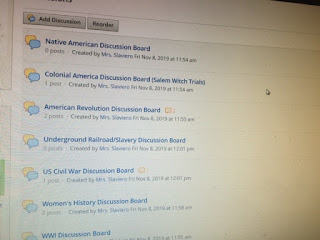Technology in History Education

My reflections this week are all about leveraging technology to positively impact students and their learning. My Language Support Historians built community by creating and viewing persuasive newscasts about the geographical regions that make up the United States. Students had the choice of using either the TouchCast app or the new (to me) green screen technology in Apple iMovie. Writing, speaking, and critical thinking skills were practiced and community building occurred when viewing. Each student wrote two compliments for each video (including their own video) and shared out. My US History 8 Historians are in the midst of researching their National History Day projects. Classes are combined every hour at this point in the project so I get to interact with close to 300 students! It's so exciting to hear how they are interpreting this year's theme (Breaking Barriers in History) and the subjects they're researching. Last year I kept noticing that I...








